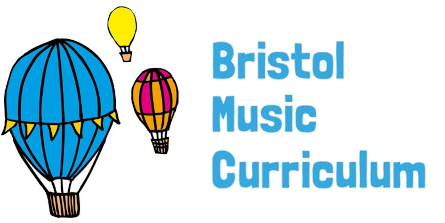Key Learning Objectives: To begin to understand that notes can move by step to form a scale. To further develop an understanding of intervals, exploring fifths. To listen carefully and perform partner songs as part of an ensemble Starter activity: Select an activity from the Pitch Starter Bank. Main activity: Introduce the degrees of a scale […]
Category: Year 3
Year 3, Unit 3: Pitch – Lesson 5
Key Learning Objectives: To further develop aural skills and understanding of how a melody moves. To work in small groups to ‘notate’ patterns of notes, using objects to mirror both rise and fall in pitch. Starter activity: Select an activity from the Pitch Starter Bank. Main activity: Representing note patterns: Listen to ‘Bristol Pitches’ and pitch pattern the […]
Year 3, Unit 3: Pitch – Lesson 4
Key Learning Objectives: To listen, explore and begin to learn ‘Fureem’. To recap that the distance between two notes is called an interval and use arms to mirror a rise and fall in pitch correctly. To understand how a triad is formed (notes built above one another to form chords). Starter activity: Select an activity […]
Year 3, Unit 3: Pitch – Lesson 3
Key Learning Objectives: To demonstrate an increased understanding of pitch through kinaesthetic learning. To perform a piece with several contrasting parts within a large ensemble. Starter activity: Singing exercise using ‘Bristol Pitches’, the pupils to listen again and sing the note names, whilst raising a hand to mirror the rising pitch. Main activity: Performance activity, split […]
Year 3, Unit 3: Pitch – Lesson 2
Key Learning Objectives: To develop an understanding of pitch through kinaesthetic learning. To understand that the pitch of an instrument is often determined by the size of the instrument. To explore a partner song and sing the songs together in ensemble. Starter activity: Engage with an activity from the Pitch Starter Bank. Main activity: Revisit the […]
Year 3, Unit 3: Pitch – Lesson 1
Key Learning Objectives: To develop an understanding of pitch through kinaesthetic learning. To listen to and trace the pitch of a melody. To learn that the leaps in-between notes are called intervals. Starter activity: Engage with the ‘aeroplane trail’ activity, found in the Pitch Starter Bank. Main activity: Listening and response exercise based on the track ‘Land […]
Year 3, Unit 2: Junk Percussion – Lesson 6
Key Learning Objectives: To explore timbre, texture and rhythm using everyday items as instruments. To listen to and repeat a variety of rhythms using instruments. To play in an ensemble and develop ensemble and listening skills. To explore experimental music by composing rhythms. Starter activity: Select an activity from the Rhythm Starter Bank. Main […]
Year 3, Unit 2: Junk Percussion – Lesson 5
Key Learning Objectives: To explore timbre using everyday items as instruments. To listen to and repeat a variety of rhythms using instruments. Starter activity: Select an activity from the Rhythm Starter Bank. Main activity: Watch the provided videos from ‘Stomp’ the musical and discuss unusual aspects of the performance, focusing on choice of instrumentation and […]
Year 3, Unit 2: Junk Percussion – Lesson 4
Key Learning Objectives: To compose and play rhythms including rests. To understand how rests are notated. To begin to notate rhythms including rests. Starter activity: Select an activity from the Rhythm Starter Bank. Main activity: Recap the symbol for a crotchet (quarter note) rest. Pupils to tip cups to create a 4 beat rhythm and […]
Year 3, Unit 2: Junk Percussion – Lesson 3
Key Learning Objectives: To understand that rhythm is a pattern made of notes of different lengths. To understand that rests are beats of silence. To play and compose rhythms that use rests. Starter activity: Introduce the concept of rests using four cups to represent four beats. The cups are positioned to either represent a sounded […]
